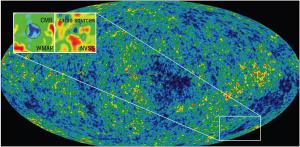Blog
Cold Comfort
19 September 2014
 WMAP
WMAPThe cosmic microwave background (CMB) is the thermal afterglow of the primordial fireball we call the big bang. One of the striking features of the CMB is how remarkably uniform it is. Still, there are some small variations in temperature at various points in the sky. This is actually expected, and in fact the scale at which these fluctuations occur tells us a great deal about the structure of the universe. But there is also a fluctuation that isn’t expected, and its cause is a bit of a mystery. It is known as the CMB cold spot, and there has been much speculation as to its cause.
The CMB cold spot is not particularly colder than other cold regions of the CMB, but it is unusual because it is a particularly cold region surrounded by a rather warm region. Simulations of random fluctuations in a CMB estimate that the odds of such a cold spot happening in the universe is about 1 in 100. So it’s possible that it is just a random fluctuation. But the 1% odds is small enough that some astronomers have looked for a possible cause, and these ideas have ranged from the mundane to the wild.
One idea is that the cold spot is due to a large void in that particular direction. We know that galaxies cluster into clumps of galaxies separated by regions with very few galaxies. Since the cosmic microwave background lies beyond these galaxies, the light from the CMB must pass through regions of clusters and voids to reach us. The gravitational effects of clusters can make the CMB in that direction appear warmer, while the lack of gravitational interactions in voids can make it appear cooler. This is a well-known phenomenon known as the Sachs-Wolfe effect. If there were a particularly large void (sometimes referred to as the Eridanus supervoid) it could explain the cold spot in that direction. There has been some evidence for such a void, but very recent work suggests that any such void isn’t large enough to produce the cold spot.1 So that doesn’t seem to be the solution.
A more speculative idea is that the cold spot is due to gravitational influences from a parallel universe.2 If there were such such a thing in a cosmic “multiverse” then the CMB would be a place to look. The claim has gotten a lot of press, but there’s little evidence to support it. In particular, according to the model there should be a corresponding cold spot on the other side of the universe, but there doesn’t seem to be such a thing.
The most common explanation is that the CMB cold spot is just an odd random fluctuation. It may be unusual, but not so unusual that it actually needs an underlying cause. In fact, even the claim of it being statistically unusual can be debated. While some statistical methods show it to be unexpected, others don’t recognize it as unusual at all. And we know that sometimes if you look for an unusual feature strongly enough you will eventually find one.
So while it is worth studying, it isn’t worth inventing parallel universes to explain.